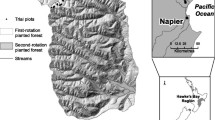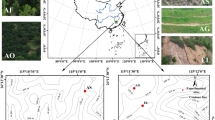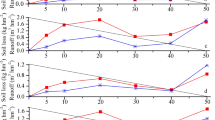Abstract
Purpose
Soil erosion and loss threatens vast tracts of agricultural and non-agricultural land, worldwide. High soil erosion severely affects establishment of vegetation via effects on plant growth and productivity on already degraded lands. However, information on soil loss impact on tree plantation and their relationships is scarce in the ravine lands. Therefore, we assessed soil loss effects on tree growth and soil characteristics, and role of conservation measures in degraded ravine land.
Methods
The study consisted of comparing three systems, i.e., terracing, trenching, and sole slope to observe the effects on soil erosion and the resultant losses. In first system, a terraced land was designed from ravine top to bottom by dividing the slope into the four plots. In second system, ninety-seven trenches sized 2.0 m × 0.5 m × 0.5 m were designed on slope, while in third system, a continuous slope was maintained. Twenty-seven trees were planted at 8 m × 8 m spacing in each system. In all the systems, annual runoff, soil loss, tree growth, biomass and carbon stock, and soil properties were observed for the 7 years.
Results
Annual soil loss was recorded highest (5.1 t ha−1 year−1) in slope followed by trench (4.4 t ha−1 year−1) and terrace (3.8 t ha−1 year−1) systems, during the 7 years. In the slope system, increased soil loss resulted in the decreased tree height and collar diameter growth by 3–12% and 12–21%, respectively. Total biomass, carbon stock, and CO2 sequestration declined by 44–86% with the increased soil loss on the slope during the same period. Tree canopy area was also recorded lower in the slope, compared to terrace and trench measures. The soil loss relationship with tree characteristics revealed that growth, biomass, carbon stock, and canopy area consistently declined with the increased soil loss. In soil, proportional loss of organic carbon (11–21%), nitrogen (10–13%), phosphorus (25–32%), and potassium (4–13%) was also observed with increased soil erosion on the slope, compared to conservation measures. In contrast, soil loss reduction in the terrace and trench based measures improved the tree growth, biomass, carbon stock, and soil properties during the same period.
Conclusion
The soil loss negatively affected the tree growth, productivity and their restoration potential, while soil conservation measures showed strong potential to ameliorate the highly eroded ravine slopes. Therefore, tree plantations should be augmented with the appropriate soil and water conservation measures for achieving greater ecological and economic benefits in degraded ravine lands.







Similar content being viewed by others
Data availability
Raw data is available with ICAR-IISWC, Dehradun, India.
References
Ali S, Sethy BK, Singh RK, Parandiyal AK, Kumar A (2017) Quantification of hydrologic response of staggered contour trenching for horti-pastoral land use system in small ravine watersheds: a paired watershed approach. Land Degrad Dev 28:1237–1252. https://doi.org/10.1002/ldr.2517
Amutha D (2014) An analysis of Sapota fruit cultivation in Tuticorin district. Inter J Econ Manag Sci 3:4. https://doi.org/10.4172/2162-6359.1000203
Andres P, Jorba M (2000) Mitigation strategies in some motorway embankments (Catalonia, Spain). Restor Ecol 8:268–275
Bagdi GL, Mishra PK, Kurothe RS, Arya SL, Patil SL, Singh AK, Bihari B, Prakash O, Kumar A, Sundarambal P (2017) Post-adoption behaviour of farmers towards soil and water conservation technologies of watershed management in India. Int Soil Water Cons Res 3:161–169. https://doi.org/10.1016/j.iswcr.2015.08.003
Bakker MM, Govers G, Rounsevell MDA (2004) The crop productivity-erosion relationship: an analysis based on experimental work. Catena 57:55–76. https://doi.org/10.1016/j.catena.2003.07.002
Bouchoms S, Wang Z, Vanacker V, Oost KV (2019) Evaluating the effects of soil erosion and productivity decline on soil carbon dynamics using a model-based approach. Soil 5:367–382. https://doi.org/10.5194/soil-5-367-2019
Chaturvedi OP, Kaushal R, Tomar JMS, Prandiyal AK, Panwar P (2014) Agroforestry for wasteland rehabilitation: mined, ravine, and degraded watershed areas. In: Dagar J et al (eds) Agroforestry Systems in India: Livelihood Security & Ecosystem Services. Springer, New Delhi, pp 233–271. https://doi.org/10.1007/978-81-322-1662-98
Dagar JC and Singh AK (2018) Ravine lands: greening for livelihood and environmental security. Springer, Singapore https://doi.org/10.1007/978-981-10-8043-2
De Moraes Sá JC, Séguy L, Tivet F, Lal R, Bouzinac S, Borszowskei PR, Briedis C, dos Santos JB, da Cruz HD, Bertoloni CG, Rosa J, Friedrich T (2015) Carbon depletion by plowing and its restoration by no-till cropping systems in Oxisols of subtropical and tropical agro-ecoregions in Brazil. Land Degra Dev 26:531–543. https://doi.org/10.1002/ldr.2218,2015
Espigares T, Moreno-de las Heras M, Nicolau JM (2011) Performance of vegetation in reclaimed slopes affected by soil erosion. Restor Ecol 19:35–44. https://doi.org/10.1111/j.1526-100X.2009.00546.x
Fang Y, Zhang H, Cheng Y (1999) Progress of sediment concentration measurement. Eng J Wuhan Univ 3:55–57
Franzluebbers AJ, Doraiswamy PC (2007) Carbon sequestration and land degradation. In: Sivakumar, Mannava VK, Ndiangui, Ndegwa (eds) climate and land degradation. springer, Berlin, Heidelberg, pp 343–358. https://doi.org/10.1007/978-3-540-72438-418
García-Fayos P, Recatalá TM, Cerdá A, Calvo A (1995) Seed population dynamics on badland slopes in southeastern Spain. J Veg Sci 6:691–696
Goldstone JA (2002) Population and security: how demographic change can lead to violent conflict. J Int Aff 56:3–22
Grime JP (2001) Plant strategies, vegetation processes and ecosystem properties, 2nd edn. Wiley, Chichester
He X, Wang Y, Li T, He S, Zheng Z, Zhang X, Huang H, Yu H, Liu T, Lin C (2019) Phosphorus losses under heavy rain from the sloping farmlands in the purple hilly region of Southwestern China. J Soils Sediments 19:4005–4020. https://doi.org/10.1007/s11368-019-02347-x
Homer-Dixon TF (1994) Environmental scarcities and violent conflict: evidence from cases. Int Secur 19:5–40. https://doi.org/10.2307/2539147
Jackson ML (1973) Soil chemical analysis. Prentice Hall of India Pvt. Ltd., New Delhi, pp 20–30pp
Jiao J, Zou H, Jia Y, Wang N (2009) Research progress on the effects of soil erosion on vegetation. Acta Ecol Sin 29:85–91. https://doi.org/10.1016/j.chnaes.2009.05.001
Kumar G, Kurothe RS, Brajendra, Vishwakarma AK, Rao BK, Pande VC (2014) Effect of farmyard manure and fertilizer application on crop yield, runoff and soil erosion and soil organic carbon under rainfed pearl millet (Pennisetum glaucum). Indian J Agric Sci 84:816–823
Kumar R, Bhardwaj AK, Rao BK, Vishavkarma AK, Bhatnagar PR, Patra S, Kumar G, Kakade V, Dinesh D, Pande VC, Singh G, Dobhal S, Sharma NK (2020a) Development of degraded ravine lands of Western India via Sapota (Achras zapota) plantation with terracing vs. trenching-on-slope based conservation measures. Land Degrad Dev. https://doi.org/10.1002/ldr.3691
Kumar R, Bhatnagar PR, Kakade V, Dobhal S (2020b) Tree plantation and soil water conservation enhances climate resilience and carbon sequestration of agro ecosystem in semi-arid degraded ravine lands. Agri Forest Meteo 282-283:107857. https://doi.org/10.1016/j.agrformet.2019.107857
Kurothe RS, Singh HB, Tiwari SP, Pande VC, Bagdi GL, Sena DR, Vishwakarma AK, Kumar G (2013) Fifty years of research in soil and water conservation. CSWCRTI, Research Centre, Vasad, India, pp.10–100
Kurothe RS, Kumar G, Singh R, Singh HB, Tiwari SP, Vishwakarma AK, Sena DR, Pande VC (2014a) Effect of tillage and cropping systems on runoff, soil loss and crop yields under semiarid rainfed agriculture in India. Soil Tillage Res 140:126–134. https://doi.org/10.1016/j.still.2014.03.005
Kurothe RS, Vishwakarma AK, Sena DR, Kumar G, Rao BK, Pande VC (2014b) Decision support system for contour trenching. Ind J Soil Conser 42:143–153
Lal R (2001) Potential of desertification control to sequester carbon and mitigate the greenhouse effect. Clim Chang 51:35–72. https://doi.org/10.1023/A:1017529816140
Larney FJ, Izaurralde RC, Jansen HH, Olson BM, Solberg ED, Lindwall CW, Nyborg M (1995) Soil erosion—crop productivity relationships for six Alberta soils. J Soil Water Conserv 50:87–91
Mehta H, Kumar R, Dar MA, Juyal GP, Patra S, Dobhal S, Rathore AC, Kaushal R, Mishra PK (2018) Effect of geojute technique on density, diversity and carbon stock of plant species in landslide site of north West Himalaya. J Mountain Sci 15:1961–1971. https://doi.org/10.1007/s11629-017-4768-2
Miles DWR, Swanson FJ, Youngberg CT (1984) Effects of landslide erosion on subsequent Douglas-fir growth and stocking levels in the western cascades, Oregon. Soil Sci Soc Am J 48:667–671
Obhodas J, Romano E, Castellote M, Heise S (2020) Sediment as a dynamic natural resource—from catchment to open sea. J Soils Sediments 20:2541–2545. https://doi.org/10.1007/s11368-020-02656-6
Pande VC, Kurothe RS, Singh HB, Tiwari SP, Kumar G, Rao BK, Vishwakarma AK, Bagdi GL (2013) Economic assessment of soil erosion damage on smallholder farms in marginal lands of Mahi ravines in Gujarat. Agri Econ Res Rev 26:63–71
Pande VC, Bhatnagar PR, Kumar R, Dhakshanamoorthy D (2018) Mahi ravine ecosystem services- farmers' perception, services and incentives for management. ICAR-IISWX, Vasad. Bulletin No. TB-03/V/E-2018. https://doi.org/10.13140/RG.2.2.14768.00000
Pathak P, Wani SP, Singh P, Sudi R (2004) Sediment flow behaviour from small agricultural watersheds. Agric Water Manag 67:105–117. https://doi.org/10.1016/j.agwat.2004.02.005
Petersson H, Holm S, Stahl G, Alger D, Fridman J, Lehtonen A, Lundström A, Makipaa R (2012) Individual tree biomass equations or biomass expansion factors for assessment of carbon stock changes in living biomass – a comparative study. Forest Ecol Manag 270:78–84. https://doi.org/10.1016/j.foreco.2012.01.004
Pradhan IP, Dayal P (1973) Effect of soil working on ravine afforestation. Indian Forester 99:615–620
Prosdocimi M, Jordán A, Tarolli P, Keesstra S, Novara A, Cerda A (2016) The immediate effectiveness of barley straw mulch in reducing soil erodibility and surface runoff generation in Mediterranean vineyards. Sci Total Environ 547:323–330. https://doi.org/10.1016/j.scitotenv.2015.12.076
Rao BK, Gaur ML, Kumar G, Kurothe RS, Tiwari SP (2013) Morphological characteristics and alterations in cross sections of different order streams of Mahi ravines. Ind J Soil Cons 41:20–24
Rao BK, Mishra PK, Kurothe RS, Pande VC, Kumar G (2015) Effectiveness of Dichanthium annulatum in water cources for reducing sediment delivery from agricultural watersheds. Clean- Soil Air Water 43:710–716. https://doi.org/10.1002/clen.201400265
Roa-Fuentes LL, Martínez-Garza C, Etchevers J, Campo J (2015) Recovery of soil C and N in a tropical pasture: passive and active restoration. Land Degrad Dev 26:201–210. https://doi.org/10.1002/ldr.2197
Safriel U, Adeel Z, Niemeijer D, Puigdefabregas J, White R, Lal R, Winslow M, Ziedler J, Prince S, Archer E (2005) Dryland systems. In: Ash N, Hassan R, Scholes R (eds) Ecosystems and human well-being: current state and trends: findings of the condition and trends working group. Island Press, Washington, D.C., pp 623–662
Saxena R Agarwal R (1997) Socio-eco-environmental accounting: a proposed framework for tree growers' co-operatives with a case study. Working paper 110, Institute of Rural Management, Anand, India. https://www.irma.ac.in/uploads/randp/pdf/1005_16978.pdf Accessed 30 March 2020
Shrivastava P, Kumar R (2015) Soil salinity: a serious environmental issue and plant growth promoting bacteria as one of the tools for its alleviation. Saudi J Bio Sci 22:123–131. https://doi.org/10.1016/j.sjbs.2014.12.001
Singh B, Pradhan IP, Singh A (1977) Effect of different type and times of mulching on the success and economics of afforestation in semi-arid ravenous tract of Gujarat. Indian Forester 103:120–128
Subbiah BV, Asija GL (1956) A rapid procedure for the estimation of available nitrogen in soils. Curr Sci 25:259–260
Szalińska E, Orlińska-Woźniak P, Wilk P (2020) Sediment load variability in response to climate and land use changes in a Carpathian catchment (Raba River, Poland). J Soils Sediments 20:2641–2652. https://doi.org/10.1007/s11368-020-02600-8
Tomar JMS, Rathore AC, Kaushal R, Kumar R, Jayaprakash J, Chaturvedi OP (2015) Agroforestry: a research manual. M/s Bishen Singh Mahendra Pal Singh, Dehradun
Walkley AJ, Black IA (1954) Estimation of soil organic carbon by chronic acid titrationmethod. Soil Sci 37:29–28
Wang T, Xue X, Zhou L, Guo J (2015) Combating aeolian desertification in Northern China. Land Degrad Dev 26:118–132. https://doi.org/10.1002/ldr.2190
West WP (2009) Tree and forest measurement, 2nd edn. Springer, Berlin
Xu XL, Ma KM, Fu BJ (2006) A research review of the relationship between vegetation and soil loss. Acta Ecol Sin 26:3137–3143
Yan X, Cai YL (2015) Multi-scale anthropogenic driving forces of karst rocky desertification in Southwest China. Land Degrad Dev 26:193–200. https://doi.org/10.1002/ldr.2209
Yang Z, Zhang JH, Xu JZ (2000) Growth response of Eucalyptus Camaldulensis Dehnl artificial population to slopes in arid-hot valleys, Yuanmou, Yunnan. J Soil Water Conserv 14:1–6
Zhuang S, Li Q, Lv P, Gui R (2016) Effect of liming on soil nitrogen loss in runoff from a cultivated bamboo stand. J Soil Water Conserv 71:356–363. https://doi.org/10.2489/jswc.71.4.356
Acknowledgments
The authors are thankful to the present and former Director, ICAR-Indian Institute of Soil and Water Conservation, Dehradun, India, for providing administrative support during the project work. The author is also thankful to the technical help provided by Sh. Anand Kumar, Sh. J K Vanker, Sh. B Mackwan, Sh D G Damor, and Sh. K D Mayavanshi during the experiment period. The Director, ICAR-IISWC, Dehradun granted approval for publishing this manuscript in the scientific journal.
Funding
Author (s) is thankful to ICAR-IISWC, Dehradun for funding the research project.
Author information
Authors and Affiliations
Corresponding authors
Ethics declarations
Conflict of interest
The authors declare that they have no conflict of interest.
Authors’ consent
All authors give their consent for participation and publication.
Code availability
N.A.
Additional information
Responsible editor: Paolo Porto
Publisher’s note
Springer Nature remains neutral with regard to jurisdictional claims in published maps and institutional affiliations.
Rights and permissions
About this article
Cite this article
Kumar, R., Bhardwaj, A.K., Rao, B.K. et al. Soil loss hinders the restoration potential of tree plantations on highly eroded ravine slopes. J Soils Sediments 21, 1232–1242 (2021). https://doi.org/10.1007/s11368-020-02833-7
Received:
Accepted:
Published:
Issue Date:
DOI: https://doi.org/10.1007/s11368-020-02833-7




